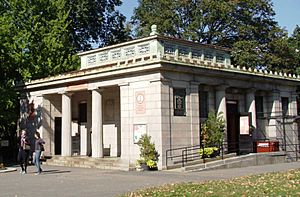Fort Greene Park facts for kids
Fort Greene Park is a public park in Fort Greene, Brooklyn, New York City. It is owned and managed by the city. This park is about 30 acres big. It was first named Fort Putnam, after a fort that stood there. That fort was named for Rufus Putnam, who was George Washington's chief engineer during the American Revolutionary War. In 1812, the park was renamed Fort Greene to honor Nathanael Greene, another hero from the Revolutionary War. Later, in 1867, famous landscape designers Frederick Law Olmsted and Calvert Vaux redesigned the park. They also designed other well-known parks like Central Park and Prospect Park. Inside Fort Greene Park, you'll find the Prison Ship Martyrs' Monument. This monument includes a special crypt that Olmsted and Vaux also designed.
Right across the street from the park's entrance on DeKalb Avenue is Brooklyn Technical High School. To the west of the park is the oldest hospital in Brooklyn, now called the Brooklyn Hospital Center. North of the park, you can find the Walt Whitman Houses. These are some of the largest public housing buildings in New York City.
Contents
Park History and Design
Early Forts and Public Space
The park is built on high ground. This was where the Continental Army created defenses before the Battle of Long Island. This battle happened early in the American Revolutionary War. General Nathanael Greene chose the spot and oversaw the building of the fort. It was called Fort Putnam, named after George Washington's chief engineer, Rufus Putnam. During the War of 1812, there was a chance the British might invade again. So, the site was used for defense once more. The newly rebuilt fort was then named Fort Greene, in honor of General Greene.
From Fort to Public Park
After the fort was no longer needed for military use, a famous poet named Walt Whitman stepped in. He was the editor of the Brooklyn Daily Eagle newspaper at the time. Whitman strongly believed that this land should become a public park for everyone to enjoy. By 1842, the City of Brooklyn had bought land around the old fort. In 1847, they officially created what was then called Washington Park. This was Brooklyn's second park, after Commodore Barry Park.
Olmsted and Vaux's Redesign
In 1867, the park got a new look. Frederick Law Olmsted and Calvert Vaux created a new design plan for it. These two designers were very famous. They had also designed Central Park and Prospect Park. At this time, the park's name was changed to Fort Greene Park.
Recent Park Improvements
In 2017, the NYC Parks Department suggested some updates for the park. Some people in the community formed a group called Friends of Fort Greene Park. They wanted to make sure the park's history was respected. The New York City Landmarks Preservation Commission looked at the plans. They wanted to make sure the changes fit with the park's original design. After some changes to the plan, it was approved. In 2018, there was a discussion about cutting down some trees. A group of residents successfully asked for a report about the trees. As of August 2018, the park's updates were being planned.
Park Monuments
Prison Ship Martyrs' Monument
One of the most important features in the park is the Prison Ship Martyrs' Monument. During the Revolutionary War, the British held American prisoners on ships. These ships were in Wallabout Bay. The conditions on these ships were terrible. About 11,500 prisoners died from sickness and not enough food. Olmsted and Vaux imagined a special underground room, called a crypt, to hold their remains. They also wanted a fitting monument above it. The crypt was built, and the prisoners' remains were placed there in 1873. A small monument was also built at that time.
Later, enough money was raised for a much larger monument. The design firm of McKim, Mead, and White won a competition to design it. The monument was officially revealed in 1908. William Howard Taft, who was about to become president, helped unveil it. It is a tall granite column, about 149 feet high. It stands over the crypt. At the very top of the column is a large bronze urn. At night, four electric lights shine on the monument. Bronze eagles decorate each light shaft. Two cannons stand guard at the plaza, near the crypt below.
Park Events
Fort Greene Park hosts many fun events. Every year, there is the Fort Greene Park Summer Literary Festival. At this event, young writers, aged 7 to 18, read their work. They read alongside famous writers like Sonia Sanchez and Jhumpa Lahiri. The Fort Greene Park Conservancy also puts on a summer concert series. This is a great way to enjoy music in the park. The Greene Glass Project started in 2010. Its goal was to clean up broken glass in the park. As of 2015, this group held yearly cleanups in the summer.
See also
 In Spanish: Parque de Fort Greene para niños
In Spanish: Parque de Fort Greene para niños




